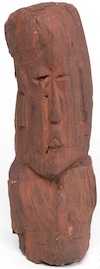
An authentic wooden statue that Mr. Patterson has been ordered to return to Mexico. Credit Bavarian State Office of Criminal Investigation.
Antiquities Dealer Leonardo ‘Leo’ Patterson’s reputation has gone from cultural heritage hero to villain during his long career. These changing perceptions mirror changing views on who are the proper custodians of antiquities and what law applies to their care and control.
Patterson came from very humble beginnings. He was born to Jamaican parents in a poor farming village on Costa Rica’s Caribbean coast. His father was mostly absent while his mother worked the land. Leo received no formal education other than a cousin teaching him to read the Bible. He broke horses and cultivated yucca and yams for a living before his mother’s early death prompted him to leave his village for Costa Rica’s capital city, San Jose.
There, 15-year-old Leo was apprenticed to a jeweler, a move that exposed him to pre-Columbian artifacts and changed his life. Costa Rica doesn’t come first to mind when one thinks of ancient artifacts. Its sophisticated Pre-Columbian cultures are nowhere near as well-known as the native cultures in Guatemala and Mexico to the North and Peru in the South. Unlike the better-known Mayans, Aztecs, and Incas, the native cultures in what is today’s Costa Rica built with biodegradable materials, not stone. Moreover, Costa Rica’s indigenous peoples largely died out after Spanish settlers brought infectious diseases, primarily the measles and smallpox, to the area. Therefore, today’s Costa Ricans do not feel the same connection to the country’s Pre-Columbian past as do inhabitants of countries with large indigenous populations.This also helps explain why back in the 1960s farmers would bring pre-Columbian gold ornaments they discovered while ploughing their fields to Patterson’s shop to be melted down for cash and not to be sold as historic artifacts.
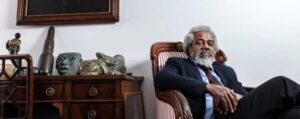
Leonardo Patterson, source Alchetron.
Even as a boy, Patterson knew such destruction was wrong. He had found some ancient pottery himself at age 7 in a yam field and became hooked after his cousin had informed him it could be thousands of years old. His fascination with the sophisticated ancient cultures that made these artifacts came to haunt him as he converted melted gold pre-Columbian artifacts into modern rings. Patterson later reflected, “I would say to myself, ‘How come I am melting this thing and this was done by another culture? I should not be doing this.” 2
Soon enough, Patterson transitioned from melting ancient artifacts into procuring and promoting them to collectors. In the early 1960s, Patterson was hired to be guide for a treasure hunter exploring Costa Rica’s jungle. He next moved to Miami to work as a jeweler where his gift of storytelling so enchanted his landlady at the time, that she reached out to a prominent collector and amateur archaeologist who took Patterson under his wing. Soon enough, young Leo, who was described as a “charmer,” was introduced to prominent New York gallery owners for whom he became a supplier.
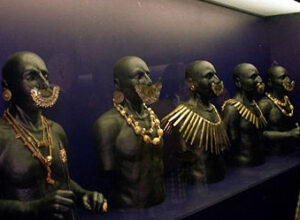
Some of the 100 gold objects from the 1996 Exhibition “The Spirit of Pre-Hispanic America” which was shown in Santiago de Compostela, in 1996, organized by Leonard Patterson. Yale University professor Michael Coe and other specialists criticized the show for including fakes, Patterson sued for defamation, then dropped the case.Photo Nacho Santàs. Terrae Antiquae.
By the late 1960s, Patterson moved to New York himself, where he sold pieces valued from thousands to millions of dollars to wealthy collectors at lavish dinner parties. If you could make it in New York, you can make it anywhere, and Patterson certainly did. By the late 1970s, Patterson maintained homes in New York and Mexico City and was always on the lookout for opportunities elsewhere.
In 1980, Patterson arranged to sell some $2 million in pre-Columbian antiquities to a group of Australian businessmen who sought to take advantage of generous tax incentives for donating the pieces to local museums. At the time, a Spanish language newspaper in Mexico applauded the deal as an example of cultural exchange and Mexican authorities professed that the sale did not violate their own cultural patrimony laws.
Patterson next cemented his status as globetrotting celebrity antiquities dealer by organizing international exhibits of pre-Columbian art. His first, at the Vatican pavilion at the 1992 World Expo in Seville, Spain, won him an audience with Pope John Paul II. That exhibit helped lay the groundwork for another in 1997 at Santiago de Compostela in the Galicia region of Northern Spain. By that point, Patterson’s reputation was such that the Director of Mexico’s National Museum of Anthropology agreed to write an article for the exhibition catalogue.
Patterson received further accolades for the exhibit from a Noble laureate, Oscar Arias, who subsequently became Costa Rica’s president. Indeed, Costa Rican authorities viewed Patterson’s version of “cultural exchange” so favorably that they even appointed him “cultural attaché” to the United Nations.
But the “good times” couldn’t last, as puritanical academics partnered with local nationalists and law enforcement to spoil the “fun.” Storm clouds had started brewing in the 1970’s with the accession of many Latin American countries to the UNESCO Convention, a legal instrument that obliges signatories to provide mutual assistance in repatriating illicitly exported cultural goods.
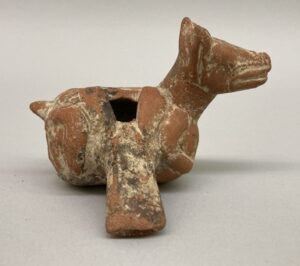
Maya. Whistle, 300-800. Ceramic, pigment, 2 7/8 × 3 × 3 7/8 in. Brooklyn Museum, Gift of Leonardo Patterson, 69.170.1. Creative Commons-BY, Photo: Brooklyn Museum, CUR.69.170.1_view03.jpg
However, Patterson first faced trouble due to accusations that some of the artifacts he sold were forgeries, claims that he dismissed as being made by jealous competitors. Yet, in 1984, the FBI gave credence to such allegations when it
arrested Patterson for wire fraud for selling a forged Mayan fresco. Although Patterson agreed to a “no contest” deal with the authorities and was placed on probation, he later maintained that the FBI was motivated by a “vendetta” against him and that the piece had been authenticated by a trained archaeologist.
Further trouble occurred a few years later, when a court revoked his probation after Patterson was arrested with eggs from endangered turtles on a layover in Huston, Texas. Patterson claimed he made an honest mistake not declaring them to Customs when he landed, because he thought he only had to declare them when he arrived at his final destination, New York. Patterson was certainly forthright about consuming the turtle eggs as part of a health regimen. He is quoted as saying, “You just eat them raw. With a little lime and ketchup – the most delicious thing you ever had.”
Although Patterson was released early from jail after one of his sons was tragically killed in a car accident, he no longer saw the United States as a good place to do business. Therefore, he moved to Germany where he befriended and sold to wealthy German, Spanish and French collectors. However, his high profile attracted additional unwanted attention.
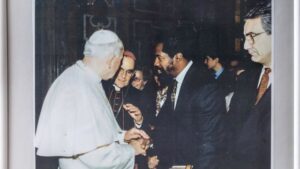
Leonardo Patterson in happier days. Source Alchetron, https://alchetron.com/Leonardo-Patterson.
First, two academics alleged that the exhibit in Galicia contained fakes, a claim that prompted Patterson to file but then dismiss a defamation lawsuit. Then, Peruvian authorities requested assistance from German authorities to recover material that allegedly had been illicitly exported from that country. Spain also launched a related investigation, claiming that material from the exhibit in Galicia was illicitly removed from Spain to Germany. In the
end, Patterson was convicted of smuggling and selling fraudulent artifacts in 2015, at age 73, although he again got off relatively easily. For all the allegations leveled against him, he was given a relatively lenient sentence of three years of home detention, a fine of approximately $40,000, and was forced to give up two wooden artifacts to Mexican authorities.
Since that time, Patterson, now in his 80’s, has apparently led a quiet life out of the limelight. The age of the globetrotting celebrity antiquities dealer appears over and there will likely never be another “Leo Patterson” with his unique version of “cultural exchange.”
This article is a public resource for general information and opinion about cultural property issues and is not intended to be a source for legal advice. Any factual patterns discussed may or may not be inspired by real people and events.
1 Peter K. Tompa is a semi-retired lawyer who resides in Washington, D.C. He has written extensively about
cultural heritage issues, particularly those of interest to the numismatic trade. Peter contributed to Who Owns the
Past? (K. Fitz Gibbon, ed. Rutgers 2005). He formerly served as executive director of the Global Heritage Alliance and now is a member of its board of directors.
2 Patrick Mcgroarty and Alexandra Olson, A colorful, checkered career in antiquities, SF Gate (October 12, 2008),
available at https://www.sfgate.com/news/article/A-colorful-checkered-career-in-antiquities-3190998.php (last
visited September 25, 2023).
3 Id.
Next Installment: Why Is Our Government Recognizing the Rights of Authoritarian Governments to
Cultural Heritage of Displaced Religious and Ethnic Minorities?
Further Reading:
Comments on MOU Request from Government of Costa Rica, Global Heritage Alliance and Committee for Cultural Policy (March 20, 2020).
Terry Ingram, Looking Back: My trip through the jungles of Mexico with Leonardo Patterson in 1980,
Australia and New Zeeland Art Sales Digest (April 2, 2020).
Sarah Cascone, Infamous Antiquities Dealer Convicted of Smuggling and Forgery, Artnet (December 9, 2015).
Tom Mashberg, Antiquities Dealer Leonardo Patterson Faces New Criminal Charges, The New York Times (Dec. 8. 2015).
Patrick Mcgroarty and Alexandra Olson, A colorful, checkered career in antiquities, SF Gate (October 12, 2008).
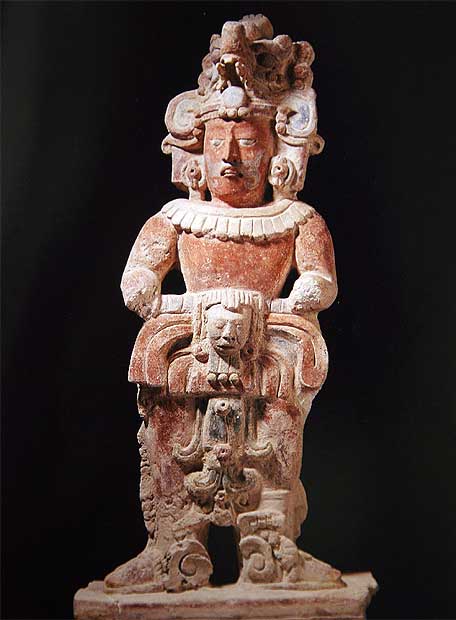 Object from the 1996 Exhibition "The Spirit of Pre-Hispanic America" which was shown in Santiago de Compostela, in the northern region of Galicia in 1996, organized by Leonard Patterson.
Object from the 1996 Exhibition "The Spirit of Pre-Hispanic America" which was shown in Santiago de Compostela, in the northern region of Galicia in 1996, organized by Leonard Patterson. 

